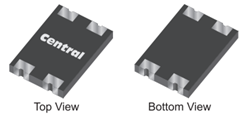Enhancing PoE Devices with Schottky Bridge Rectifiers
August 12, 2020 in
What is Power over Ethernet (PoE)?
PoE has become one of the most convenient and efficient technology developments in modern networking. First conceived in the late 1990s and later standardized in 2003 via IEEE 802.3af, PoE technology allows for both power and data to be transmitted across a single ethernet cable from a PoE ethernet switch. This allows for device operation and data communication without requiring a power supply and ethernet switch. PoE systems are made up of two primary device types: power sourcing equipment (PSE), such as PoE switches or PoE injectors, and powered devices (PD), such as cameras or smart lighting hubs. The original IEEE standard dictated a 15.4 W power sourcing rating from PSE to PD, and has since been amended multiple times. The most recent amendment to the PoE IEEE standard was in September 2018 via IEEE 802.3bt type 4, which dictates a 100 W power sourcing rating.Every PoE PD requires an efficient bridge rectifier input stage for voltage polarity correction as the maximum voltage differential seen on a typical ethernet line can be +/- 48 V, which is equivalent to 96 V max. With this application specifically in mind, Central Semiconductor has developed and released its CBRDFSH Schottky bridge rectifier series, ideal for PD input voltage polarity correction.
-schottky-bridge-rectifiers-1-(1).png?lang=en-US&height=116&width=250) The CBRDFSH series of devices has a lower maximum voltage drop than standard full-wave bridge rectifiers, which translates to a low forward conduction loss. This is an essential aspect for PoE systems as the total number of viable PDs is proportionate to the collective input efficiency of the PDs; higher input efficiency translates to more viable PDs on any one network. These Schottky bridge rectifiers are available with a reverse voltage capability of 100 V, which is ideal for the potential voltage differential seen on network CAT transmission lines. Additionally, these devices feature Central’s new, low-profile BR DFN package, ideal for space-constrained PDs.
The CBRDFSH series of devices has a lower maximum voltage drop than standard full-wave bridge rectifiers, which translates to a low forward conduction loss. This is an essential aspect for PoE systems as the total number of viable PDs is proportionate to the collective input efficiency of the PDs; higher input efficiency translates to more viable PDs on any one network. These Schottky bridge rectifiers are available with a reverse voltage capability of 100 V, which is ideal for the potential voltage differential seen on network CAT transmission lines. Additionally, these devices feature Central’s new, low-profile BR DFN package, ideal for space-constrained PDs.
CBRDFSH Series in your designs
Since the output voltage polarity of a full-wave bridge rectifier is independent of the input voltage polarity, they are often used in PD input stages. This ensures that the PD is biased properly when crossover cables are used. Central offers two different forward rectified current ratings: 1 and 2 amperes, with a reverse voltage rating of 100 volts. With this voltage rating, these Schottky bridge rectifiers are compatible with all 48 V PSE supplies, as they provide correction coverage for the full voltage swing. In addition, these devices accommodate the power sourcing amendments made to IEEE 802.3 via IEEE 802.3at, IEEE 802.3bt type 3, and IEEE 802.3bt type 4.Depending on the type of PSE used in the PoE system, power is either sourced on the main pins or spare pins of the RJ45 connector. With an End-Span system, power and data are both sourced on the main pins: 1, 2, 3, and 6. This configuration is commonly used when a new PoE system is being constructed. With a Mid-Span system, data is sourced on the main pins, but power is sourced on the spare pins: 4, 5, 7, and 8. This configuration is commonly used when a PoE system is already in place and port expansion is the primary goal. However, for this reason, polarity correction is required on both PD pin set inputs. This requirement became mandatory for PDs as of amendment IEEE 802.3at, which states that two bridge rectifiers must be used in the input stage of a PD, one delegated to each input pin set.
In all PoE systems, power available at the PD is always lower than what the PSE can source. Additionally, more power is lost to heat while the PoE system operates. This makes the use of power-efficient technology in PoE applications extremely crucial. Perhaps the greatest advantage in using Central’s CBRDFSH devices is the low forward voltage drop that contributes to a much lower power loss in the PoE system. A low forward voltage drop is also ideal for the power classification phase of PoE systems. Two voltage pulses are provided by the PSE to the PD and travel across an impedance inside the PD controller. The PSE then records the current across the PD controller and utilizes it to calculate the impedance, which in turn is used to determine a power class. Large current usage via the Schottky bridge rectifiers will cause an accuracy issue during power classification.
-schottky-bridge-rectifiers-3.png) Transient Voltage Suppressor (TVS) diode utilization for circuit protection is also an important consideration. Voltage should be selected based on the voltage rating of the system. At least a 400 W rating is required for indoor applications, with higher power ratings required for outdoor systems. Central’s P4SMA, P6SMB, and 1.5SMC series TVS diodes are ideal for this requirement. For example, a 48 V indoor PoE camera system requires at least a 400 W 58 V TVS diode; Central Semiconductor’s 400 W, 58 V P4SMA58A in the SMA package is an ideal selection.
Transient Voltage Suppressor (TVS) diode utilization for circuit protection is also an important consideration. Voltage should be selected based on the voltage rating of the system. At least a 400 W rating is required for indoor applications, with higher power ratings required for outdoor systems. Central’s P4SMA, P6SMB, and 1.5SMC series TVS diodes are ideal for this requirement. For example, a 48 V indoor PoE camera system requires at least a 400 W 58 V TVS diode; Central Semiconductor’s 400 W, 58 V P4SMA58A in the SMA package is an ideal selection.
BR DFN Package Benefits
-schottky-bridge-rectifiers-4.png) Another significant advantage of Central’s CBRDFSH series is the low profile package design. Similar bridge rectifier designs are only available in the HD DIP, with a typical profile of 2.7 mm, whereas the BR DFN package has a typical profile of 1.2 mm, 54% thinner than the HD DIP. This is a major positive for space savings in the z-direction, allowing for the creation of low-profile PDs, particularly beneficial for sensors and cameras. Additionally, the flat, no-lead package allows for increased power and heat dissipation in the PD. This is made possible by the large contact area between the BR DFN and the printed circuit board (PCB), thus creating enhanced levels of thermal efficiency.
Another significant advantage of Central’s CBRDFSH series is the low profile package design. Similar bridge rectifier designs are only available in the HD DIP, with a typical profile of 2.7 mm, whereas the BR DFN package has a typical profile of 1.2 mm, 54% thinner than the HD DIP. This is a major positive for space savings in the z-direction, allowing for the creation of low-profile PDs, particularly beneficial for sensors and cameras. Additionally, the flat, no-lead package allows for increased power and heat dissipation in the PD. This is made possible by the large contact area between the BR DFN and the printed circuit board (PCB), thus creating enhanced levels of thermal efficiency.
Conclusion
Central’s CBRDFSH series devices are perfect for polarity correction in any PoE powered device, at any power classification level. They provide an exceptional all-in-one solution for decreasing power loss and package height, and yielding an increase in electrical and mechanical efficiency. Whether for a new application or to improve the efficiency in a current design, Central’s CBRDFSH Schottky bridge rectifier series has design engineers covered.-schottky-bridge-rectifiers-5.png)
Interested in learning more about Central's PoE devices?
Contact us today.

About AEM
AEM specializes in high-reliability electronic components for aerospace, defense, space, industrial, and medical applications where failure is not an option. We transform challenges into revolutionary breakthroughs that empower people to bring their vision to life.
-schottky-bridge-rectifiers-2.png)